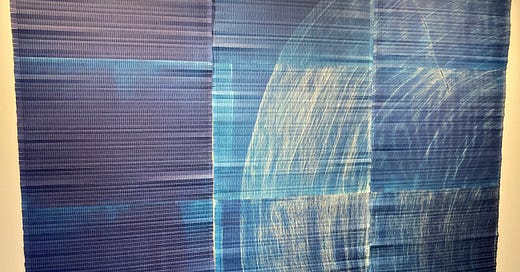
October 26, 2024 (edited same date)
South Royalton, VT — If you ever wondered what it would take to capture a tree in a large scale photograph, cut it to shreds, then grab needle and thread and weave it back together, all on a backdrop of Prussian blue, look no further than Vermont Law and Graduate School.
It’s in this quintessentially environmentally forward-thinking educational institution’s art gallery that Tunbridge, VT artist and sculptor Elizabeth Billings demonstrates her artistic prowess. She’s turned the real into the ethereal, and the three-dimensional into a wondrous display of 2D morphing into 3D abstracted cyanotypes in blue and white that strike at the mind and heart.

Billing’s “Artist Statement” of the trees she depicts follows, reading aptly like a love poem:
I want to be a tree. Standing in place, giving out oxygen, taking in carbon dioxide, sending messages with my roots, bursting into bloom, swaying in the wind, setting my next year’s buds, letting go of all my leaves.
Do I want to be a tree? Or what I think it is to be a tree?
I look up the word “tree”. It’s an unsatisfactory exercise.
I look up, “what would we do without trees?
I read: “Without them, we lose extraordinary and essential functions for life on earth.”
“Without trees, we lose extraordinary and essential functions for life on earth.”
Without them.
And what are we with them?
I lean into a tree, resting my forehead against its bark, my hands on its trunk, I remember visiting my great aunt, she’d always rest her forehead against mine. Not a brief handshake kind-of-thing, a long connecting kind-of-thing. A sharing of breath.
It is the same with the trees.
I am filled with the world trees give us, the world we are with trees.
It is essential.
And,
it is extraordinary.
If I were a tree, oxygen would be coursing through my roots, my trunk,
my branches, and my leaves,
for you.
If I were a tree,
I wouldn’t be talking about me.
A cyanotype is a camera-less photographic technique, where the artist places an object on paper that has been coated with an iron-salt solution. It’s then exposed to UV light and washed, yielding an image of the object in white surrounded by a color we know as Prussian blue.
Beyond the image, Billings has taken no small steps to cut the paper into thin horizontal strips, then has sewn them back together with black thread in what must have been a painstakingly time-consuming and intricately manual process. She never takes the easy path, and her art captivates as a result. These large-scale, almost accordion-like Roman shades of blue and white hang well above head height and greater than our arms span wide to dominate the gallery just as trees, monolithic and beautiful, inhabit the landscape. Look closely at the detail of each piece. Their sewn-together-ness suggests the root structures by which all trees seem interwoven and interconnected. These pieces speak as if of one strong voice, even though wall space intervenes—perhaps projecting a metaphor of how our lives could best be lived.
With this show, Billings captures the essence of trees, exposing to us their souls in an abstracted and elemental way that delivers a fresh perspective of these leafy neighbors who feed our every breath with life-giving oxygen. Her art offers hope, buoys us up, leaves us breathless. Billing's’ trees, like the great aunt in her Artist Statement, lean into us with love every day of our lives. They care for us perpetually. As trees exhale oxygen, so should we share our breath and exuberant breathlessness of their power and resilient might with them.

The conversation Billings’ art has started must continue. Oxygen is life. We need trees. Let’s consider and care for them and the entire palette of our planet’s leafy-green inhabitants as they silently and freely provide the element so singularly essential for us to inhale, to breathe, to survive.
The Dean Shirley A. Jefferson Gallery at Vermont Law and Graduate School is free and open to the public during regular business hours, Monday - Friday, 9 am - 5 pm, and on weekends, 9 am - 5 pm. Also on display is a permanent exhibit by Elizabeth Billings of interactive sticks hanging from the ceiling that children (and adults, too!) enjoy manipulating and click-clacking about as if wandering through a stand of saplings in a wooded landscape. This current show runs through December 31, 2024.
Dave Celone is vice president for alumni relations and development at Vermont Law and Graduate School, of which he is also an alumnus. He writes from Sharon, Vermont.





Beautiful.